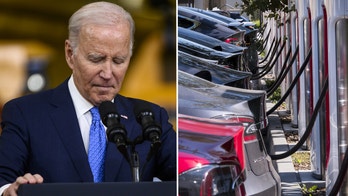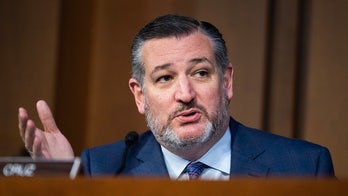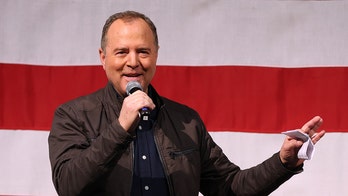
President Barack Obama meets with President Francois Hollande of France in the Oval Office of the White House in Washington, Tuesday, Nov. 24, 2015. Hollande's visit to Washington is part of a diplomatic offensive to get the international community to bolster the campaign against the Islamic State militants. (AP Photo/Andrew Harnik)
There is something very “French” about being “American.”
Profile pictures on Facebook and Twitter accounts are still sheathed with French flags, more than two weeks after the terrorist attacks in Paris.
Only moments after the deadly rampage, President Obama took to the airwaves to remind the public that “France is our oldest ally. The French people have stood shoulder to shoulder with us again and again.”
And if anyone needs to understand that unique bond, they need to go no further than the House of Representatives chamber in the U.S. Capitol.
Only two portraits adorn the wall in the House chamber on either side of the rostrum. One portrait is of George Washington. The other is of Marquis de Lafayette, a legendary figure in both the American and French revolutions.
Lafayette is known as the “Hero of Two Worlds.” An aristocrat, he paid his own way to sail to the United States to fight in the American Revolution -- helping forge the first bond between the fledging nation and the French.
Lafayette quickly became close with Washington. Washington viewed Lafayette as a son and promoted his young charge to the post of major general in the Continental Army. Lafayette was also a confidante of Thomas Jefferson and Alexander Hamilton.
Lafayette’s diplomatic skills helped him persuade his fellow French countrymen to bankroll parts of the American Revolution. A deft military strategist, Lafayette engineered a triangular trap that duped British forces at the Battle of Yorktown in 1781. Lafayette dispatched American troops to the east and French troops to the west. The York River formed the third vertice. British General Cornwallis surrendered, ensuring the American victory.
Lafayette returned to France and led forces in the French Revolution.
Lafayette came back to the U.S. in 1824 and toured all 24 states over a 14 month period. It’s estimated that about half of all Americans physically saw Lafayette on his journey.
Pope Francis held forth with a speech during the latest Joint Meeting of Congress back in September. But Lafayette was the first to address a Joint Meeting of Congress in 1824. Another foreign dignitary didn’t appear before the House again for 30 years.
The painting in the House chamber by French artist Ary Scheffer depicts Lafayette not in aristocratic garb from his native France -- but in a long brown coat draped over a black suit. Lafayette wields a cane as he strolls near a bluff.
Lafayette Square, complete with a statue of Lafayette himself, stands directly across from the White House in downtown Washington.
A French associate of Lafayette’s designed the first layout of the new capital city, Pierre L’Enfant. L’Enfant quickly focused his blueprint on a prominent slope not far from the Potomac River known as “Jenkins Hill.” L’Enfant described the impressive hillside as “a pedestal waiting for a monument.”
It was atop that plateau where the infant nation built the U.S. Capitol, renaming the overlook “Capitol Hill.”
The American nation may have forged an immediate bond with France through Lafayette and even L’Enfant. But despite President Obama’s historical note about the U.S. and France and everyone draping the French flag all over social media, it wasn’t long ago that American revulsion of the French was sport in U.S. politics.
Republicans derided Secretary of State John Kerry’s perceived aloofness as “French” as he ran for president as a senator from Massachusetts in 2004. Then House Majority Leader Tom DeLay, R-Texas, began a presentation by saying “Good afternoon. Or as John Kerry might say, ‘Bonjour.’ ”
In 2003, then French President Jacques Chirac refused to join the coalition to fight in Iraq. He threatened to use his veto at the United Nations Security Council to block a resolution to initiate the war. An anti-French frenzy seeped through Capitol Hill.
“They have resigned from any responsibility for the war on terrorism,” said DeLay of the French.
Then-House Administration Committee Chairman Bob Ney, R-Ohio, issued an edict that renamed French fries in the House cafeterias “Freedom Fries.” Ney recast French toast on the breakfast bill of fare as “Freedom Toast.”
He declared that the move was “a small but symbolic effort to show strong displeasure of many on Capitol Hill with the actions of our so-called ally, France.”
Rep. Jose Serrano, D-N.Y., took issue with Ney’s tactic, asking if French wine and “Belgian waffles” should be scrapped as well.
Then-Rep. Jack Kingston (R-Ga.) even argued that the Pentagon should scrap a multi-million dollar contract with the French food service firm Sodexho to feed the Marines.
“I abhor the idea of continuing to pour American dollars into a French-based firm when those dollars could be feeding our wartime economy,” wrote Kingston in a letter to then-Defense Secretary Donald Rumsfeld.
But by 2006, the popularity of the war waned -- as did the French bashing. The menus quietly switched, returning French fries and French toast. Not long after, the House Republican leadership bounced Ney from his chairmanship due to his ties to lobbyist Jack Abramoff. Ney later did jail time associated with the scandal.
The blip in U.S.-France relations from a few years ago wasn’t the first time the old allies stumbled. France backed Texas to be independent and tried to keep the U.S. from acquiring what is now California. President Franklin Delano Roosevelt presided over strained relations with French leader Charles de Gaulle during World War II. De Gaulle derided American efforts to build nuclear weapons and withdrew its forces from NATO in 1966.
But in the light of the terrorist attacks, French-American relations are now on the upswing. The House and Senate each conducted a moment of silence to honor the dead in the massacres. French Ambassador to the U.S. Gerard Araud appeared the night after the attacks in Lafayette Park at a candlelight vigil alongside White House Chief of Staff Denis McDonough. Senate leaders later received Araud at the Capitol and presented him with a book of signed condolences. French President Francois Hollande huddled with Obama at the White House just a few days ago.
There is something very “French” about being “American.” It’s an association represented at the core of the U.S. government, whether it be the presence of Lafayette’s portrait in the House chamber or the grid of the federal city. And like most relationships, there are arguments and fights along the way.
Sometimes, even food fights.




